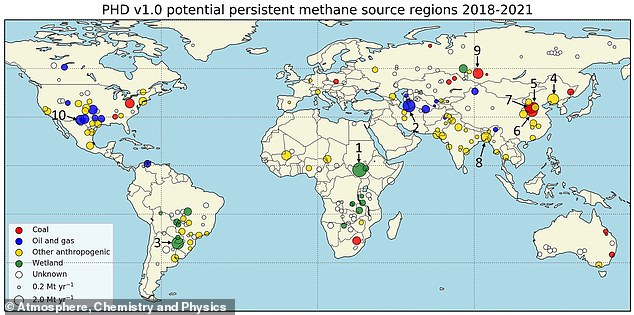
Top 10 Global Methane Hotspots Emitting Millions of Tonnes Annually
Global Methane Hotspots Revealed: 10 Regions Driving Emissions
While carbon dioxide (CO2) remains a major climate change concern, methane—28 times more potent at trapping heat—is responsible for 30% of current global warming. A new study by the University of Bremen identifies the world’s top 10 methane-emitting regions, collectively releasing 28.8 million tonnes annually.
Methane’s Growing Threat
Methane, the primary component of natural gas, leaks from fossil fuel operations, agriculture, and decaying organic matter in wetlands. Though it persists in the atmosphere for only ~12 years (vs. centuries for CO2), its short-term warming impact is devastating. Since 1850, atmospheric methane levels have surged from 680–790 parts per billion (ppb) to over 1,900 ppb.
Mapping the Hotspots
Using the European Space Agency’s Sentinel-5P satellite, researchers tracked methane emissions between 2018–2021. Satellites detect methane by analyzing unique infrared wavelengths absorbed by the gas, acting as a “fingerprint.” Persistent emitters—regions with consistently high methane levels—were flagged.
Top 10 Methane Hotspots
-
Sudd Wetlands, South Sudan (4.5M tonnes/yr)
- Source: Natural wetlands
- Warming temperatures thaw waterlogged soils, releasing stored carbon as methane.
-
West Turkmenistan Oil & Gas Fields (3.5M tonnes/yr)
- Source: Fossil fuels
- Leaks from Turkmenistan’s energy infrastructure fuel emissions.
-
Ibera Wetlands, Argentina (3.3M tonnes/yr)
- Source: Natural wetlands
-
Liaoning, China (2.9M tonnes/yr)
- Source: Landfills, agriculture, energy
-
Shanxi 1–3 Coal Fields, China (2.6M, 2.6M, 2.4M tonnes/yr)
- Source: Coal mining
-
Dhaka, Bangladesh (2.4M tonnes/yr)
- Source: Waste, livestock, rice farming
-
Kuznetsk Basin, Russia (2.4M tonnes/yr)
- Source: Coal production
- Permian Basin, USA (2.2M tonnes/yr)
- Source: Oil & gas operations
Key Findings
- 46.5% of emissions are from unidentified sources.
- Coal, oil, and gas account for 15.6% combined.
- Wetlands (7.3%) and other human activities (30.4%), like agriculture and landfills, drive the rest.
“Persistent sources—not one-off leaks—are the focus,” said co-author Michael Buchwitz. “These include wetlands, coal mines, and oil fields emitting continuously over years.”
Why It Matters
Methane’s 80x higher warming potential than CO2 over 20 years makes curbing these emissions critical. Tackling methane could rapidly reduce near-term warming, buying time for CO2 mitigation.
Images (conceptual):
- Sentinel-5P satellite mapping methane plumes.
- Aerial view of Sudd wetlands, showing vast methane-emitting marshes.
- Turkmenistan’s oil infrastructure with visible gas flares.
- Coal mines in Shanxi, China, releasing trapped methane.
Call to Action
Identifying these hotspots highlights urgent priorities for policymakers: fixing fossil fuel leaks, improving waste management, and protecting wetlands. “Mitigating methane is a fast-acting climate solution,” the study urges.
Source: Published in Atmospheric Chemistry and Physics*, this study underscores the need for global cooperation to track and tackle methane—the silent accelerator of climate crisis.
Methane Fast Facts
- Lifespan: ~12 years in the atmosphere.
- Sources: 40% natural (wetlands), 60% human (energy, agriculture, waste).
- Impact: 0.5°C of current warming linked to methane.
Image: Graph showing rising methane concentrations since 1850.


